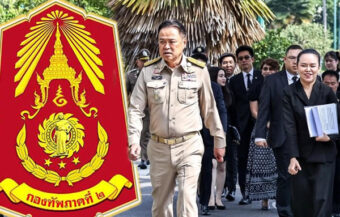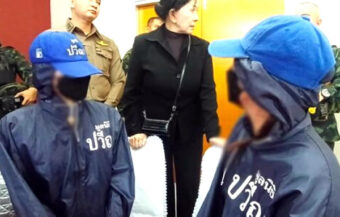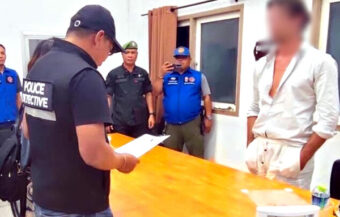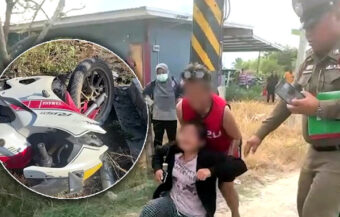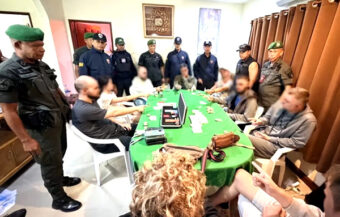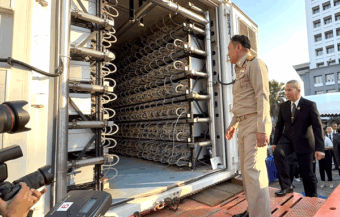Thai forces hunt Cambodia’s deadly PHL-03 rocket launchers as the war entered its fourth day. Rockets threaten 16 provinces within 130 km. Troops remain on high alert amid unconfirmed strikes. Officials urge calm, cautioning against panic and spreading rumours.
War slammed into its fourth day Sunday on the Thai-Cambodian border. After Cambodia shattered a three-hour ceasefire at 2 a.m., Thai forces launched fierce responses across multiple fronts. Unconfirmed reports surfaced that Thailand may have taken out one of Cambodia’s six deadly PHL-03 rocket launchers. These weapons are a serious threat, capable of striking deep into Thai heartlands like Nakhon Ratchasima, Chonburi and Rayong. The PHL-03’s firepower can devastate entire population centres. Yet, Lt. Gen. Winthai Suvari urged calm, warning the public not to panic while the Army verifies the situation.
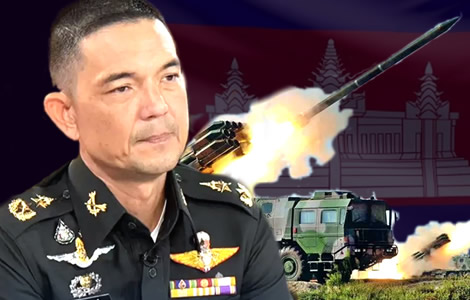
The war between Thailand and Cambodia has entered its fourth day, with fighting intensifying along several stretches of the shared border. On Sunday afternoon, the Royal Thai Army confirmed that troops had fired at a suspected Cambodian PHL-03 rocket system. However, the Army has not yet confirmed whether the missile platform was destroyed.
Although rumours spread earlier in the day about a successful interception, Army spokesman Lt. Gen. Winthai Suvari clarified the facts. He stated that the claim originated from field intelligence and not from any verified battlefield report. “The information came from initial surveillance,” he said. “As of now, we have no official confirmation of a kill.”
Thai army confirms firing at suspected Cambodian PHL-03 rocket system, but the kill remains unverified
Meanwhile, a source from the 2nd Army Region told reporters that Thai forces engaged a Cambodian rocket target in a designated strike zone. Soldiers fired in response to detected movement, believing the launch system was active. However, the source admitted that they could not verify whether the target was hit. No physical evidence or wreckage has been recovered.
Despite the lack of confirmation, both military and local officials are treating the situation as a live operational threat. Cambodian rocket activity has already been confirmed across multiple locations. PHL-03 launchers are now known to be deployed close to the Thai border.
The PHL-03 is a Chinese-made multiple rocket launcher system. It can fire 12 rockets in one volley and strike targets as far as 130 kilometres away. If all 12 missiles are launched at once, the impact zone can cover 420 rai—equivalent to over eight football fields. Cambodian units are believed to be operating at least six of these systems.
Because of the PHL-03’s extended range, the Thai military has identified 16 provinces within its potential blast radius. In the eastern region, these include Sa Kaeo, Chachoengsao, Chanthaburi, Trat, Prachinburi, Chonburi and Rayong. In the northeast, at-risk provinces include Nakhon Ratchasima, Buriram, Surin, Sisaket, Ubon Ratchathani, Maha Sarakham, Roi Et, Yasothon and Amnat Charoen.
Multiple Cambodian PHL-03 rocket systems deployed near border threaten 16 Thai provinces within 130 km
Among these, Surin Province—particularly Mueang District—remains a primary concern. This area lies directly across from confirmed Cambodian military positions. Consequently, Thai units have increased patrols and fortified key outposts in the area.
As combat entered its fourth consecutive day, military activity intensified across at least six Thai provinces. Reports have confirmed artillery exchanges, air surveillance missions and troop manoeuvres near the Sisaket and Ubon Ratchathani sectors. Cambodian forces have also shifted launch platforms repeatedly, possibly to avoid counterstrikes and tracking.
In response, the Royal Thai Army has placed all combat units in the 2nd Army Region on full alert. Anti-rocket systems, including mobile interceptors, have been deployed near critical infrastructure. Meanwhile, drone surveillance continues to scan the horizon for rocket activity.
Lt. Gen. Winthai emphasised that Thailand has the capability to intercept incoming missiles if launched. “We are ready,” he said. “Our response systems are active. We will protect civilian areas at all costs.”
Surin province under heavy watch as Thai army boosts patrols and deploys anti-rocket defences
Nevertheless, he urged the public not to panic. “Stay alert, follow updates, and trust official sources,” he advised. “Do not spread unverified information.” The warning follows a wave of social media rumours claiming additional rocket strikes that were later disproved.
At the same time, emergency response plans are being activated across all at-risk provinces. Provincial hospitals have been ordered to prepare for mass-casualty events. Mobile medical teams are being positioned near the border. Some schools in high-risk districts have suspended classes.
Additionally, local authorities have set up temporary shelters and evacuation routes in Mueang Surin and other vulnerable districts. Checkpoints have been established along major roads to monitor civilian movement and provide information to residents.
While the Army continues to manage combat operations, former officials are urging a stronger response. Retired Major General Wanchana Sawasdee said Thailand must consider offensive strikes deeper into Cambodian territory. “If Cambodia is firing long-range weapons, then long-range retaliation is justified,” he stated on Sunday.
Former officials call for deeper offensive strikes into Cambodia amid long-range missile threat
Although no formal announcement has been made, internal sources confirm that counterstrike options are under review by the Ministry of Defence. For now, operations are focused on interception and battlefield containment.
Meanwhile, backchannel diplomatic contact between Thailand and Cambodia remains open. A senior Foreign Ministry official described the dialogue as “ongoing but fragile.” However, there is currently no ceasefire agreement and no external mediation has been initiated.
ASEAN has released a brief statement urging restraint, but has not taken any active role in peace efforts. Thailand continues to insist that any resolution must begin with a full halt to Cambodian rocket attacks.
Airspace over the conflict zone remains restricted. Surveillance aircraft and military drones are conducting nonstop patrols to locate rocket sites and enemy movements. Intelligence reports indicate Cambodia is moving launchers to avoid detection.
Ministry of Defence reviews counterstrike options as fragile diplomatic talks continue with no ceasefire
As of this writing, no PHL-03 rocket has been officially confirmed as intercepted. However, the Army continues to analyse surveillance data and battlefield telemetry. Updates will be released once verification is possible.
The situation remains active. Military officials expect further clashes as both sides maintain combat readiness. No signs of de-escalation have been reported. For now, Thai forces remain in control of their defensive lines. But the risk of expanded hostilities remains high.
Thai Deputy Minister of Defence explains Cambodia broke the Trump brokered ceasefire Sunday morning
Thai military warns Cambodia about the deployment of Chinese made long range missiles against civilians
Citizens living within the 130-kilometre danger zone are urged to follow official guidance, avoid unnecessary travel, and remain prepared for sudden developments. The war is ongoing, while the threat from long-range rocket attacks still hovers over eastern Thailand.
Join the Thai News forum, follow Thai Examiner on Facebook here
Receive all our stories as they come out on Telegram here
Follow Thai Examiner here
Further reading:
Thai Deputy Minister of Defence explains Cambodia broke the Trump brokered ceasefire Sunday morning
Hot War rages on the Thai Cambodian border with Cambodian troops on the offensive in Chong Bok area
14 killed and over 100,000 evacuated as army brings in more guns trained on Cambodian border forces


